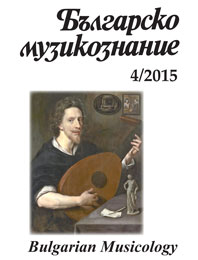Музикалноструктурен и художественообразен анализ на цикъла „Ко Пресвятей Владычице“, оп. 43 от Павел Чесноков
Analysis of the musical structure and the imagery of the cycle To the Most Holy Mother of God (Op. 43) by Pavel Tschesnokoff
Author(s): Rositsa NikolovaSubject(s): History, Theatre, Dance, Performing Arts, Fine Arts / Performing Arts, Cultural history, Music
Published by: Институт за изследване на изкуствата, Българска академия на науките
Keywords: sacred chants; stylistics; music constructing; Orthodox lyrics; the Holy Mother of God; intonational features; Russian polyphony.
Summary/Abstract: Pavel Tschesnokoff composed a cycle of sacred choral works Op. 43 in 1914, when the best part of emblematic of the so-called New School in Russian Sacred Music were written, including Rachmaninoff’s Liturgy (Op. 31), Grechaninov’s Passion Week (Op. 58), etc. The cycle evinces the characteristics of the composer’s already mature manner. The cycle has seven chants performed a cappella according to the tradition of Orthodox denomination. The canonical lyrics for Orthodox hymns and chants To the Most Holy Mother of God have not been borrowed from the same liturgical order of service: three of them are part of the Supplicatory Canon To the Most Holy Mother of God and the rest four are part of the order of service found in the Vespers, the First Hour, Sunday Matins and Our Lady of Kazan Feast Day Service (feast day: on 22 October or 4 November); still, all these are united by the general idea of praising the Holy Mother of God and prayerful hope in Her. Various music techniques, including polyphony, were used to compose the pieces.
Journal: Българско музикознание
- Issue Year: 2015
- Issue No: 4
- Page Range: 79-97
- Page Count: 19
- Language: Bulgarian
- Content File-PDF

